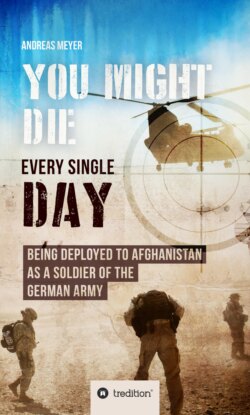Читать книгу YOU COULD DIE ANY DAY - Andreas Meyer - Страница 4
ОглавлениеContents list
Prologue
1 January 2005
2. Preparations
3. March 2005
4. June 2005, Mission
5. Every day camp life
6. Support from Austria
7. A baker and his flatbread
8. At the medic`s
9. Earthquake in Pakistan
10. My time in between the missions
11. Second deployment
12. The next flight to Afganistan
13. Preparation for handover
14. Challenges at the IEB-Cell
15. Visit tot he police chief at the airport
16. First tasks fort he new unit
17. Charity for a orphanage
18. Meeting again after 13 years
19. The Blue Moque of Mazar-E-Sharif
20. Visit by the commander
21. Driving tot he Teacher Training Center
22. Religious dignitaries at Camp Marmal
23. The newbies are coming
24. Getting acquainted with medical personal during flight
25. A day in the camp with five students
26. Afghanistan-Projekt „no más fonteras“
27. US-American artist arrives
28. The great day oft he experiment has come
29. Trip tot he border and port city Hairatan
30. First visit tot he OCCR headqzarters
31. Viait oft he Gouvernor of Samangan
32. The first watch on the watch tower
33. Support in driving service for OCCR
34. Mr. Scholl-Latour visits Camp Marmal
35. My third mission
36. And back again in Mazar-e Sharif
37. After 16 days camp stay
38. The first days in office as troop supply officer
39. Support fort he engineer squad
40. Evening remembrance service for four fallen comrades
41. The blue heart of Feyzabad
42. Lunch with „Schoko“
43. A reunion with Nabil, Sultan, Soraya
44. Attack on German armed forces in Takhar province
45. Father`s Day run at Camp Feyzabad
46. Departure
47. Back home
48. Eqilogue
49. Attachment 1 Rank groups from army
50. Attachment 2 Mongolian ranks
51. Attachment 3 Breakdown of a guide
52. Attachment 4 Classification of NATO classes
53. Attachment 4 Translation from German to Dari
54. Attachment 5 in alphabetic order
55. Attachment 6 List of figures
Thanks to:
F
or the patient support in the implementation of this book, I thank my friend Jana Wochnik-Sachtleben, who has lectured the text, and recorded my audio book, as well as Ms. Miriam Hadji for the design of the impressive book cover, and the translators Maren Krüger, Kerry S and Alexander Langer.
I warmly thank my comrade and friend Nabil Azizi for the translation into Dari language.
I also especially thank my partner, "Thessi", for her constant support the whole time.
I would also like to thank the following former senior officers and civilians as well as all my former comrades who dealt with me directly and indirectly in the missions:
Brigadier A., Airborne Brigade 25,
Colonel B., former company commander paratrooper battalion 253, Nagold,
Brigadier General R., former commander of the Center for Operational Information in Mayen,
Peter Scholl-Latour, German-French journalist and publicist from Bad Honnef,
Batuz, an American artist, philosopher and cultural activist,
and my closest comrades in the time of the missions (2005, 2010, 2011), Rainer M., Thomas K., Tino M., Marcel G., Soraya A., Sultan A., Nabil A., Alexander B., Marc -Andre S., Tobias M., Stephan M., Christian W.
Pretext:
These words are mine, a report from a staff sergeant of the reserve, who retired from active service in the German Army in 1990, but after a six-year break decided to live a life in uniform again and volunteered as a reservist for three missions in Afghanistan.
Previously, I had been soldier for eight years, but what I had learned those days was nothing to put into practice at that time, because back then there was no mandate for foreign missions for the Bundeswehr.
Then, after the attacks on the World Trade Center in New York, USA, on September 11, 2001, the circumstances changed.
From this point on, the Bundeswehr also participated in the foreign missions of the NATO troops. In December 2014, the ISAF mission ended in Afghanistan and a new advisory and training mission began.
During the period from 2001 to the end of 2014, a total of 3,687 soldiers, including 54 German soldiers, lost their lives. All were comrades, some of them were my friends.
This is my - and their - story.
